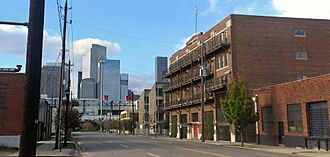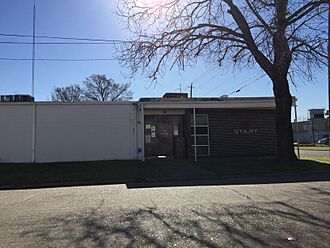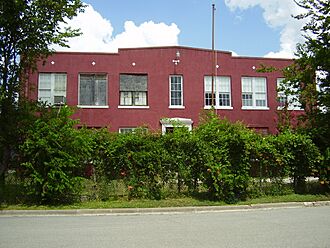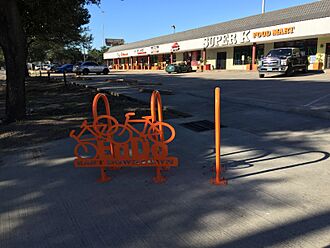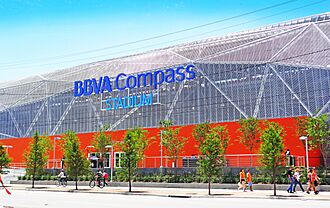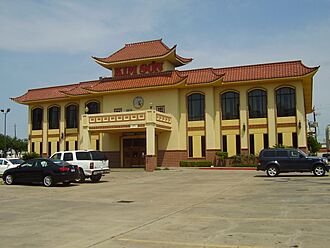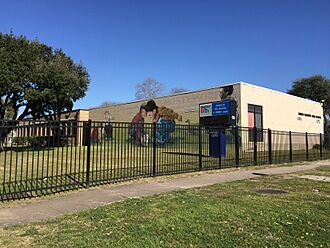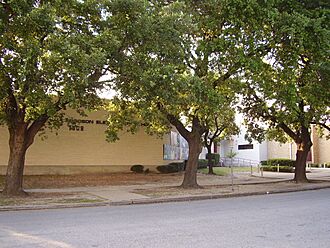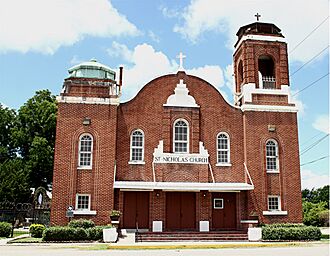East Downtown Houston facts for kids
East Downtown Houston (often called EaDo) is a lively area in Houston, Texas. The East Downtown Management District helps manage and improve the area. Its main office is at START Houston, a shared workspace at 1121 Delano Street. EaDo is located just east of Downtown Houston and north of Interstate 45. It sits between the George R. Brown Convention Center and the East End neighborhood.
EaDo is also home to the Old Chinatown, which is Houston's first Chinatown. This area is bordered by Interstate 69/U.S. Route 59, Preston Street, St. Joseph Parkway, and Emancipation Avenue. It's important to know that this Old Chinatown is different from the much newer and larger Chinatown in southwest Houston.
Contents
A Look Back: EaDo's History
In the 1930s, many Cantonese immigrants moved to what was then part of the Third Ward. They came from Downtown Houston looking for more affordable land. These immigrants opened businesses like grocery stores and restaurants. They also celebrated Chinese New Year there. Later, people from other East Asian countries, like Vietnam, also moved into this Chinatown area.
By the early 1950s, many Chinese businesses moved to the southeastern edge of Downtown Houston. This area became the new center for the Chinese community. More Asian immigrants, including many from Vietnam, arrived in Houston in the 1970s and settled here. By the 1980s, the area had a theater, supermarkets, warehouses, a bank, and many restaurants.
A man named Lang Yee "Bo Bo" Woo helped develop the old Chinatown in the 1970s. When the Houston Center opened downtown, more people started visiting Chinatown. Newspapers even wrote articles about it. There was hope that the new George R. Brown Convention Center would help Chinatown grow even more. However, this support didn't really happen. After Woo passed away, Dan Nip became a key leader for the area.
By the late 1980s, more and more Chinese families began moving to suburbs like Southwest Houston and Fort Bend County. The old Chinatown also couldn't grow much because it was surrounded by other neighborhoods and Downtown. There were plans to help the old Chinatown develop, but an economic downturn made it hard for these plans to happen.
Many of the development plans never came true. The sewer system wasn't big enough for new buildings. Also, a main street connecting Chinatown to Downtown was closed when the Brown Convention Center expanded. By the 1990s, many East Asian businesses had moved to the new Chinatown in southwest Houston.
In 2002, a writer described this area as a "no-man's-land." He said the name "Chinatown" no longer fit. The area got its current name, "EaDo," in the late 2000s. In 2008, the management district asked for new name ideas. "EaDo," short for "East Downtown," was chosen as one of the most popular suggestions.
Around 2009, the East Downtown authority started using the new "EaDo" name. By 2010, many artists began to live and work in EaDo, creating a new artistic community.
Cool Places to Visit in EaDo
One of the most famous spots in EaDo is Shell Energy Stadium. This stadium is home to the Houston Dynamo soccer team and the Texas Southern University football team. It's special because it was the first soccer-specific stadium in MLS to be built right in a downtown area. The stadium can hold over 22,000 people and hosts not just soccer and football, but also concerts and boxing matches.
EaDo's Look and Feel
EaDo is located southwest of the Second Ward. It has a unique look, with the large George R. Brown Convention Center in the background. You can see tall skyscrapers and modern new homes next to older warehouses. Some of these warehouses are still used for storage.
In the past, many Hispanic families lived in small houses here. But with the opening of Shell Energy Stadium and Minute Maid Park, EaDo started to change. By 2015, many older houses were being replaced by new townhouses, bringing in new residents.
EaDo's Businesses
The main office and a restaurant for Kim Sơn, a well-known Vietnamese restaurant chain, are located in East Downtown.
EaDo also has the former U.S. headquarters of Schlumberger, a big energy company. This building has a cool Art Deco design. After being empty for a while, it was bought by David Denenburg in 2016. He plans to fix it up and add shops.
Culture and Community
The Texas Guandi Temple is a special place in East Downtown. It was built in 1999 by a Vietnamese couple, Charles Loi Ngo and Carolyn. They decided to build a temple to Guan Yu (Guandi), a Chinese god, after they survived a difficult situation at their store. They believed Guandi saved them. A Vietnamese refugee named Charles Lee helped raise money for the temple. He wanted to thank the United States for welcoming him. The temple welcomes people of all religions and has beautiful, fragrant halls.
The Chinese Cultural Center used to be in the old Chinatown. The Governor of Texas at the time, Dolph Briscoe, even attended its opening.
Helping the Homeless
EaDo has been known for having a number of people experiencing homelessness. Many gather here because there are agencies and groups nearby that offer help like food, clothing, and shelter. Most of Houston's non-profit and faith-based groups that help the homeless are located in Downtown and Midtown. A large shelter for women and children is on Emancipation Avenue, and a men's shelter is also nearby.
Recently, there has been some discussion between developers who want to build new projects in EaDo and those who help the homeless. It's a topic of ongoing discussion how these services will continue as the area grows and changes.
Getting Around EaDo
Since 2015, the METRORail light rail system has served EaDo. You can use the EaDo/Stadium station on the Green and Purple lines. The Leeland/Third Ward station is also on the Purple Line. Besides the light rail, the Metropolitan Transit Authority of Harris County (METRO) also has bus services throughout the area.
Schools in EaDo
EaDo is part of the Houston Independent School District.
- For elementary school, students in EaDo attend Lantrip Elementary School or Burnet Elementary School.
- For middle school (grades 6-8), students go to Yolanda Black Navarro Middle School of Excellence (which used to be Jackson Middle School).
- For high school, students attend Austin High School or Wheatley High School.
- The special magnet high school, High School for Law and Justice, is also located in EaDo.
A Look at School History
St. Nicholas Elementary School opened in 1887. It moved to its current location around 1920. A new school building was built in 1931.
Charles W. Luckie Elementary School, located at 1104 Palmer, was a school for African-American students. It closed around 1943.
Dodson Elementary School used to serve parts of EaDo. In 2014, the school board decided to close Dodson Elementary. The Energy Institute High School, a special magnet school, moved into the former Dodson Elementary building in 2014. In 2018, Energy Institute High School moved to its current campus in the Third Ward.
Anson Jones Elementary School, which is outside EaDo, also used to serve parts of the area. It closed in 2006.
Places of Worship
The Roman Catholic Archdiocese of Galveston-Houston has two important places in EaDo:
- St. Nicholas Church is Houston's oldest Black Catholic church. By 2012, the church started holding services in Swahili because many African immigrants joined the church.
- The Catholic Charismatic Center is also in EaDo.


